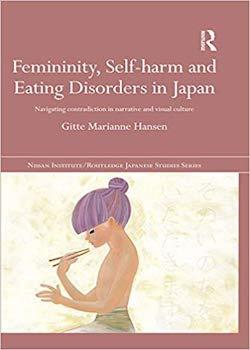Femininity, Self-harm and Eating Disorders in Japan

By Gitte Marianne Hansen
Routledge, 2015
ISBN-13: 978-1138905306
Review by Charlotte Goff
Hansen tells us in the introduction to Femininity, Self-harm and Eating Disorders in Japan that its inspiration came from a conversation overheard not in Japan, but the Copenhagen fitness club where she worked before moving to Japan. The three subjects which form the mainstay of this analysis are concerns worldwide, but Hansen uses Japanese visual and narrative culture as a window into their thematisation in the specific context of contemporary Japan. Through careful evaluation of media including anime, manga, television drama and literature, Hansen addresses three central questions. First, she asks what constitutes normative femininity in contemporary Japan. Second, Hansen questions how this normative femininity is presented in Japanese culture. Finally, she asks how self-harm and eating disorders and their cultural representations relate to normative femininity.
Modern Japanese women, Hansen argues, find themselves torn between conflicting norms of femininity. The traditional feminine norm sees woman as mother and wife, positioning her within the domestic sphere, whilst a more recent but co-existing norm locates women outside, in the social world. Under pressure to perform multiple, paradoxical roles in order to be accepted as women, Hansen claims that both female characters and some real women show signs of fragmentation. These women seek both to navigate ‘contradictive femininity’ and repair their fragmented selves. For the female characters in visual and narrative culture, techniques such as the ‘doppelganger’ are deployed. Hansen looks for example at Yazawa Ai’s manga series NANA, in which two female characters both named Nana double up in order to fulfil expectations in both domestic and social spheres. In Anno Moyoco’s Hataraki-man (working man),[1] female character Matsukata Hiroko is able to transform between one version of herself located in the traditional female norm, and another self, described as male, who is a successful journalist.
Non-fictional women, Hansen points out, are unable to use the techniques open to their created counterparts. These women therefore turn, sometimes, to maladaptive coping mechanisms including self-harm and eating disorders. Whilst she does not claim that self-harm and eating disorders are exclusively the products of mixed messages about femininity, Hansen conceives them as tools sometimes used in the battle to navigate contradictive femininity. I was left wondering why Hansen chose to put self-harm and eating disorders in one category, beyond their shared use of self-directed violence. It would have been interesting to see more consideration of related behaviours such as suicide: though suicide is a huge concern in Japan, Hansen mentions it only briefly, and blurs the distinction between self-harm and attempted suicide. However, she raises interesting points about the culturally-defined nature of what societies consider to be healthy or sick, questioning the norms which dictate that self-cutting and purging are pathologised, whilst cutting in the context of piercings or tattoos, or strict dieting, are thought healthy.
Some of the most interesting parts of this text were Hansen’s interpretations of implicit themes in Japanese culture. Her point that the name ‘Midori’ can be considered a shorthand for someone rebellious, who doesn’t follow social norms, as well as her analysis of Murakami’s short story Midori iro no kemono (the little green monster), prompted me to reconsider my belief that Murakami’s books could be discounted so quickly for portrayals of women who are passive and written to distract or cater to the lone male protagonists. Hansen put forward a case for Murakami as an author who, rather than perpetuating these negative images of women, exposes and implicitly criticises them. Similarly, she subverts the accepted idea that the female protagonists who predominate Studio Ghibli’s output always represent a positive image of femininity, through a detailed analysis of implicit themes of disordered eating in Spirited Away.
It is clear that for Hansen, ‘feminine’ is not a fixed position, but rather exists on a spectrum. Hansen discusses female representations as varied as the woman trapped in sand in Otsuichi’s short story Mukashi yūhi no kōen de (long ago at dusk in the park), to the housewife-turned-model Miki Makoto in television drama Bara iro no seisen (the rose-coloured crusade), to artist Aida Makoto’s Toretate ikura-don (bowl of rice with fresh salmon roe) in which a young girl, stomach squeezed by male hands, dispenses salmon roe from her vagina. She jumps, too, between different forms of cultural product: from anime to text, and from TV drama to visual art. Because of this, in addition to its obvious appeal for people interested in women’s studies and mental health, Hansen’s book should appeal to anyone wanting insight into diverse Japanese narrative and visual media.
[1] Translations are Gitte Marianne Hansen’s.

